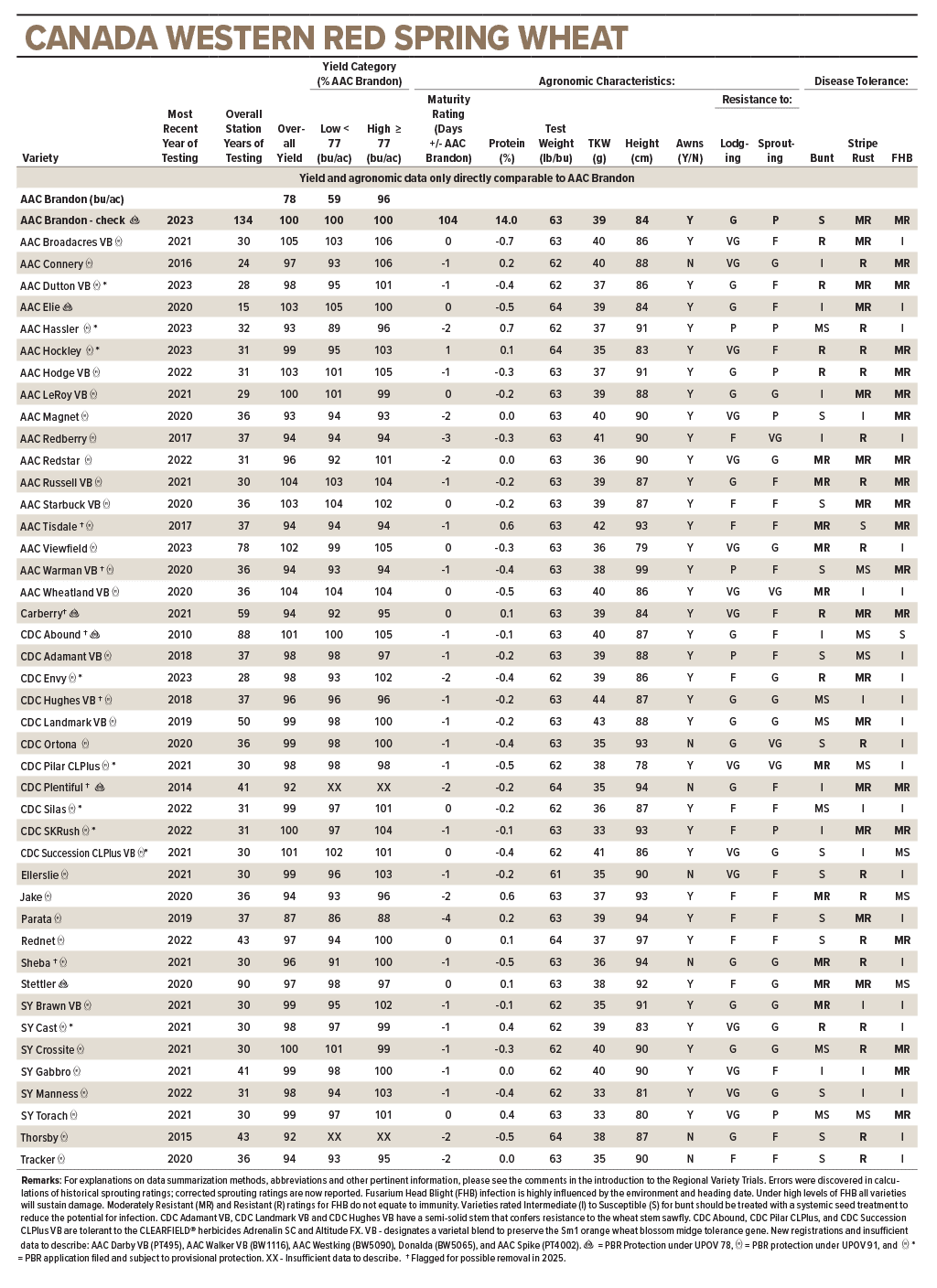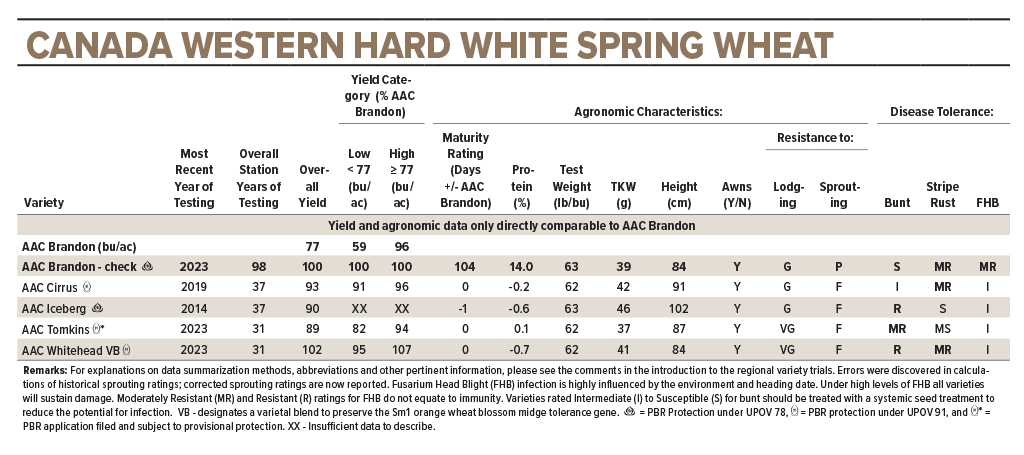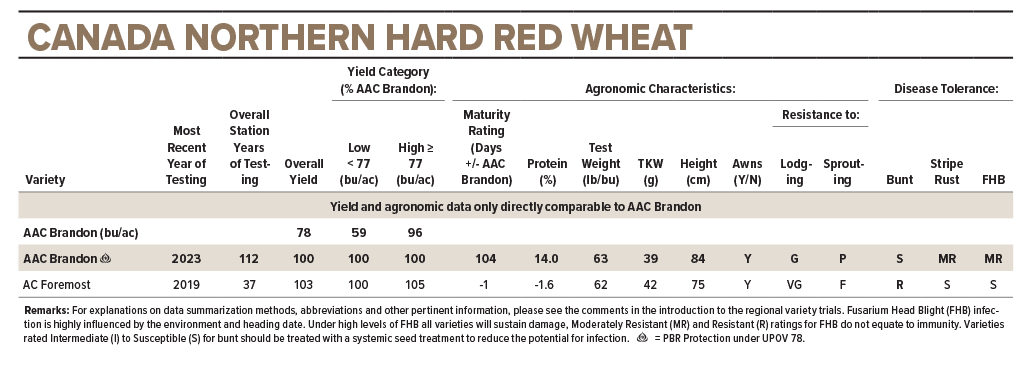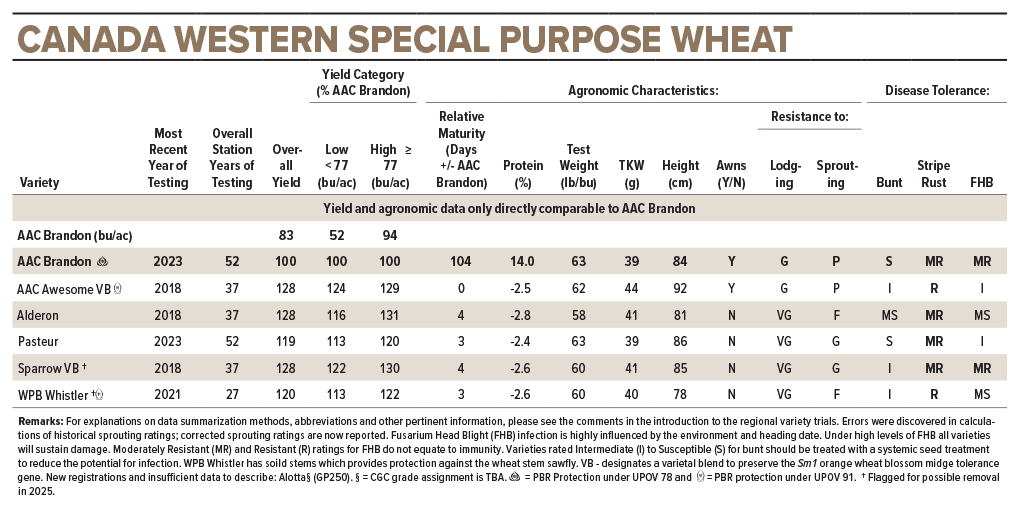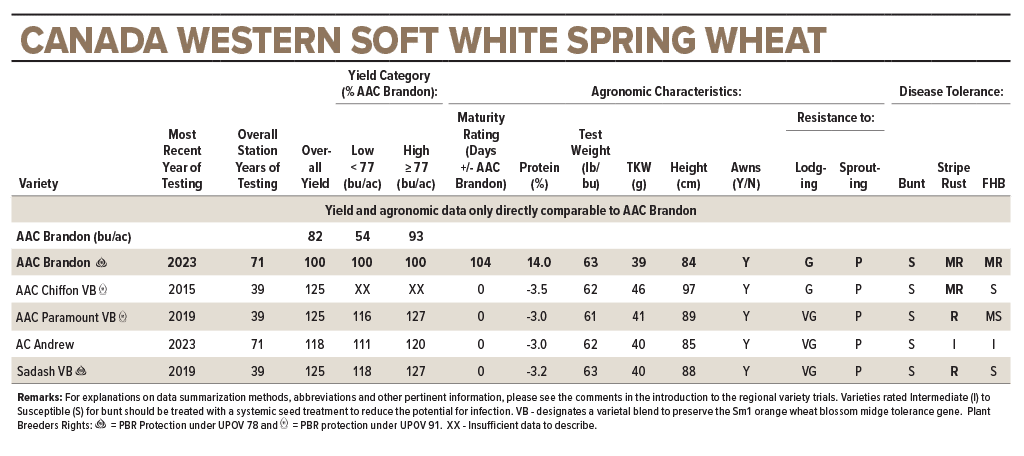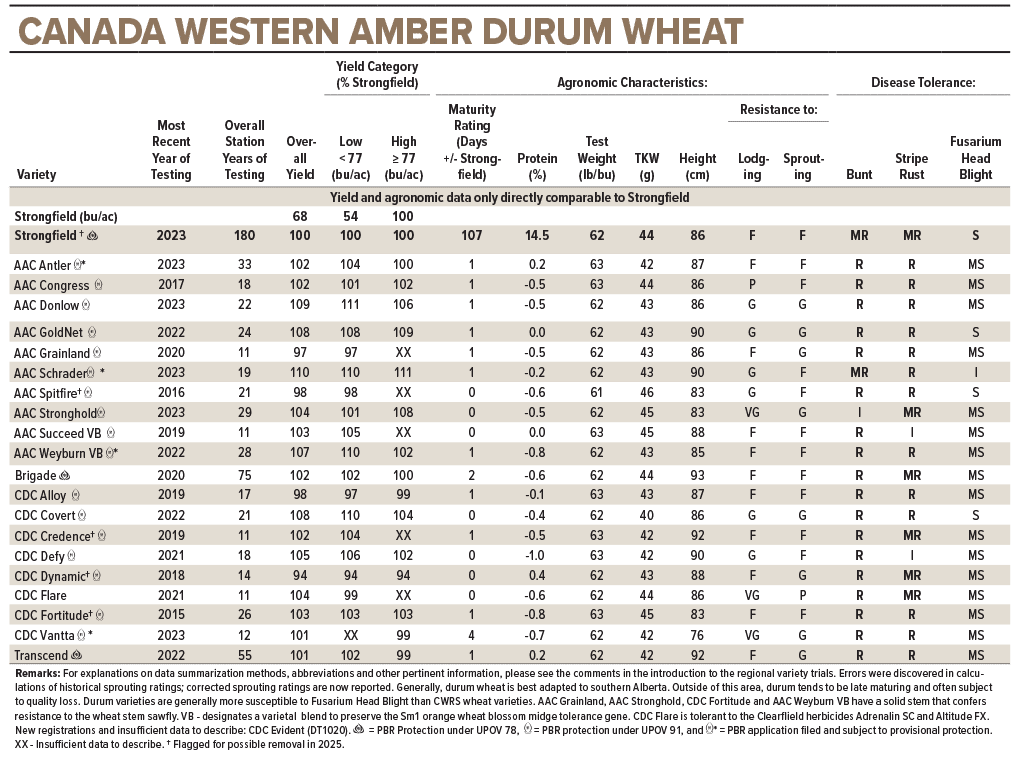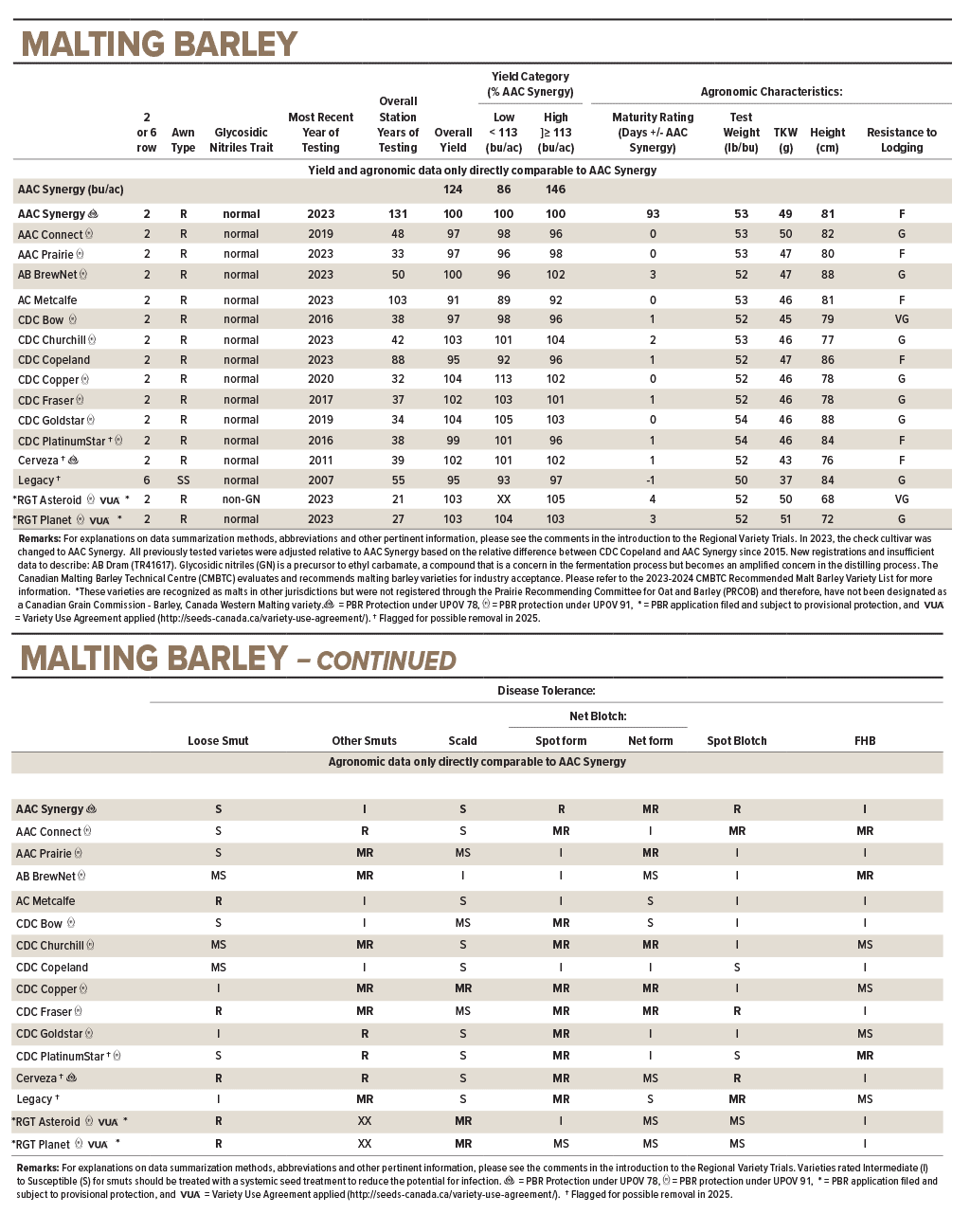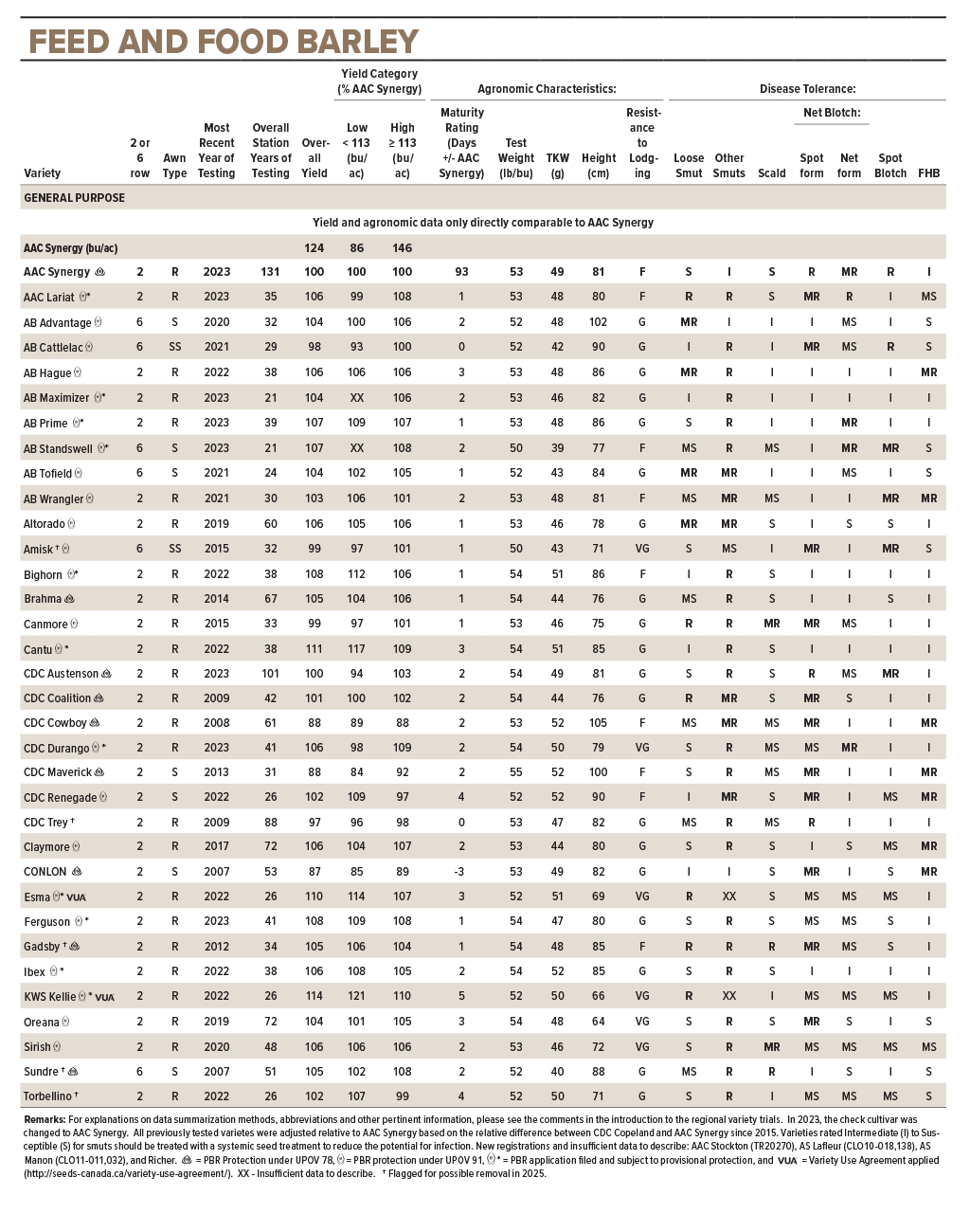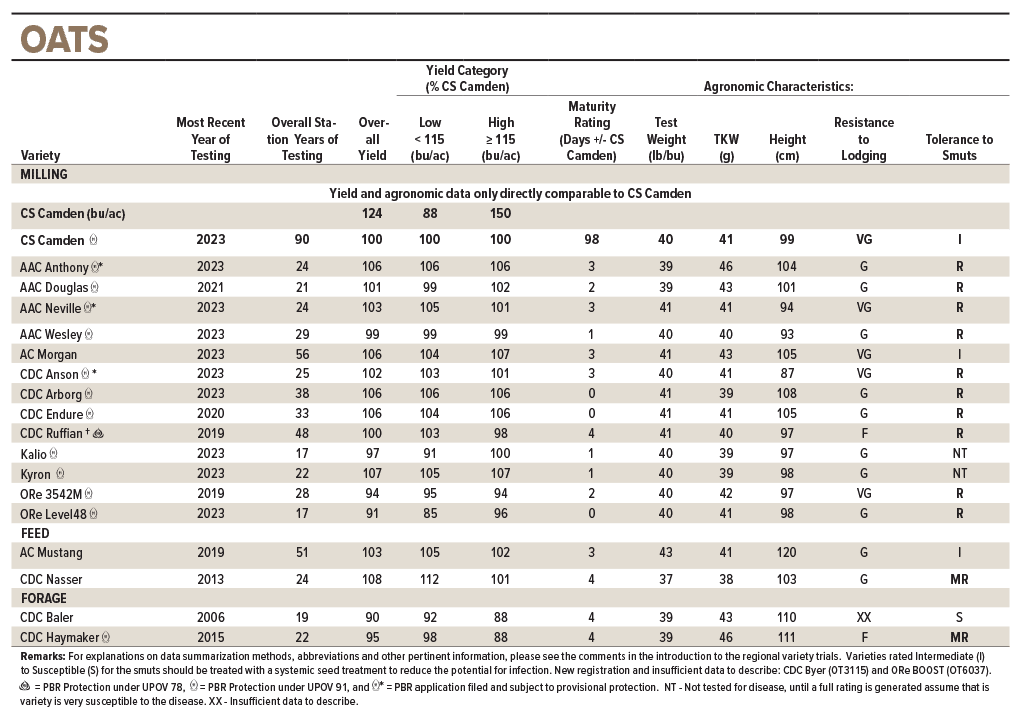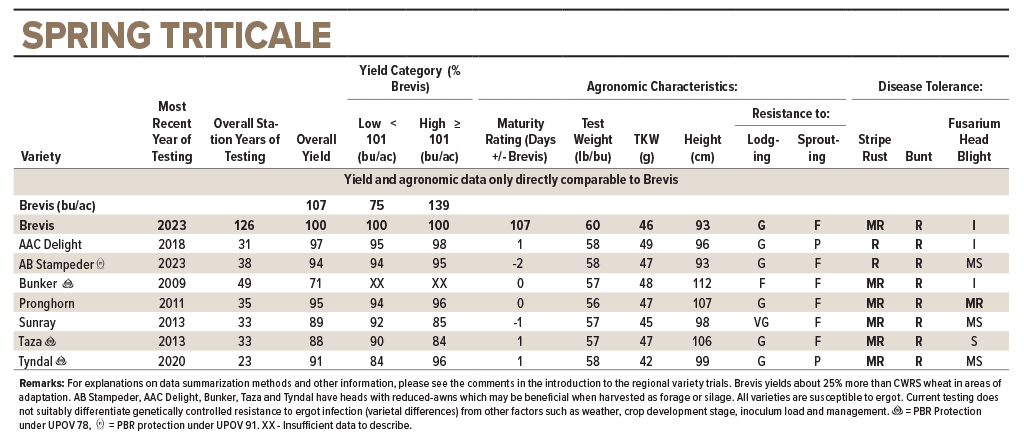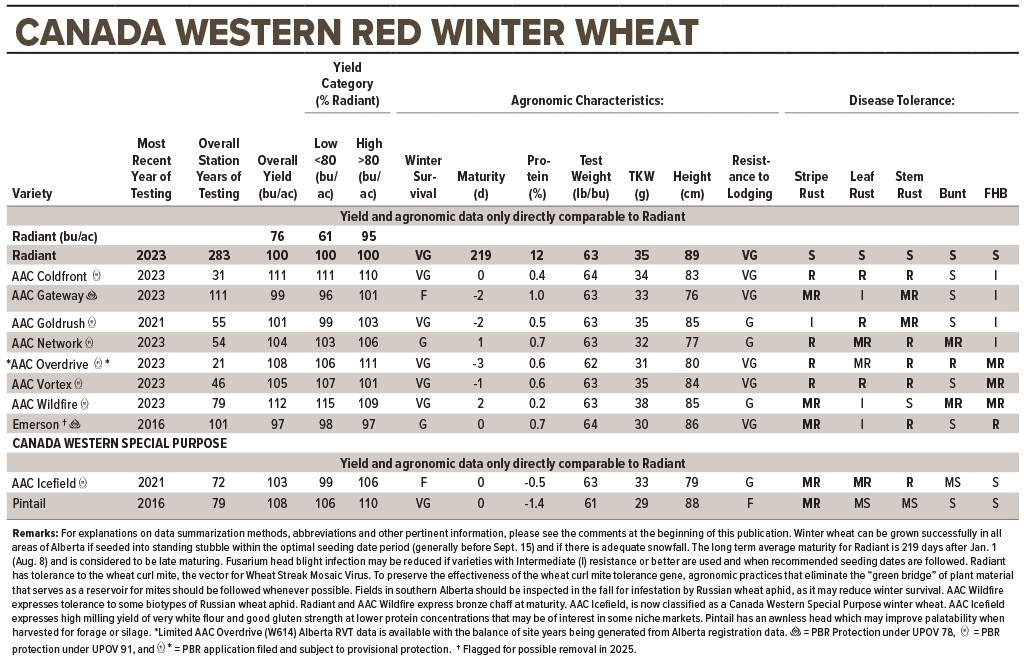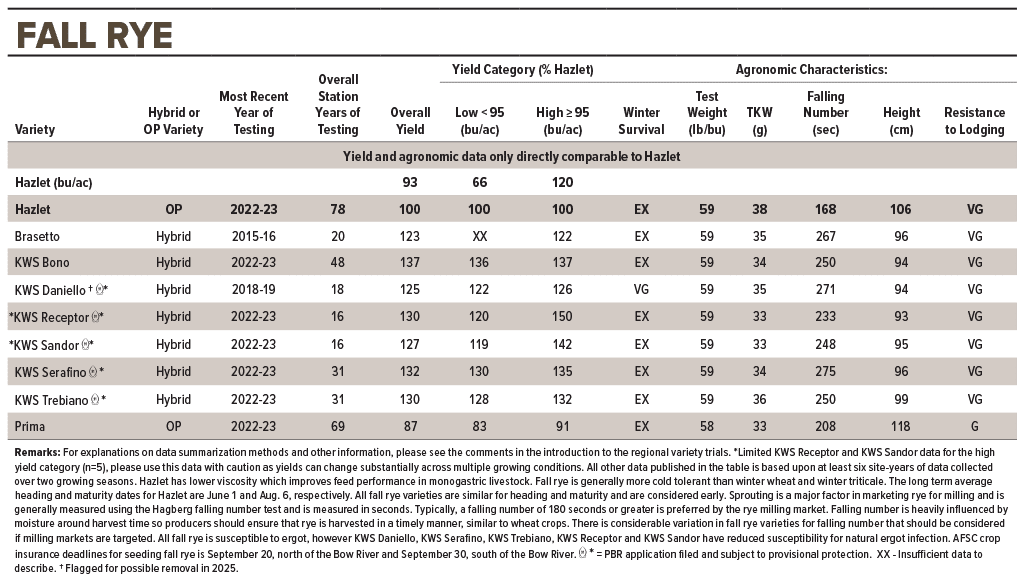Varieties of Cereal and Flax for Alberta
This annual publication provides information on cereal and flax variety performance in Alberta. Important agronomic characteristics and disease resistance information is provided for varieties of wheat, barley, oat, rye, triticale and flax.The Alberta Regional Variety Testing program for cereals and flax is coordinated by the Alberta Regional Variety Advisory Committee (ARVAC) and Alberta Grains. The information and tables are prepared, reviewed and approved by ARVAC.
To view a video explaining how to use the tables to pick a new variety click here.
Funding for the program is generously provided by public and private industry groups
- Alberta Grains
- Alberta Oat Growers Association
- Alberta-British Columbia Seed Growers
- Alberta Seed Processors
- Results Driven Agriculture Research
- Western Grains Research Foundation
See list of seed companies that pay annual entry fees as program entrants.
Data for This Publication Comes from Various Sources
See annual contributors to field trials and data sources.
Starting in 2022, registration data going back to 2018, was incorporated into the RVT database from Alberta sites and Saskatchewan sites with growing conditions similar to Alberta. Registration data for disease resistance ratings havealways been used for the Alberta Seed Guide. Moving forward, all tables include maturity, lodging, test weight, thousand kernel weight, protein, and yield data with appropriate checks and newly registered varieties, from relevant Alberta and Saskatchewan registration sites. This registration data is included along with Alberta Regional Variety Trial (RVT) site data in Alberta’s historical databases which are used to generate the Alberta Seed Guide tables.
Sincere thanks are extended to all individuals and organizations who contribute to this publication.
Impact of Growing Season on Data Quality
Yearly trial results are greatly impacted by the growing season conditions. View the summary of the annual trial quality as impacted by the growing season.
Crop Coordinators
Crop coordinators are specialists in the crop type they coordinate and are often a plant breeder or experienced technician working in the crop.
Varieties Reported in the Tables
A variety must be registered by the Canadian Food Inspection Agency (CFIA) to appear in the tables. Publication normally occurs after two years of testing; however, entries are accepted with the understanding that testing will occur for at least three years.
Varieties without pedigreed seed production in Alberta within the past two years, following five years of full registration to facilitate adoption, and/or if the variety has dropped below one per cent of the commercial acreage of the crop kind (or market class) in the province (based on AFSC crop insurance data) will be flagged for removal from the tables. After the variety has been flagged for removal for one year, it may be removed from the tables unless an objection is received for consideration at the annual meeting. Notwithstanding the above criteria, a variety can be retained in a table if a compelling case is made. In cases where both the breeding institution and seed distributor wish to have a variety deleted from the table, removal can occur without a notification flag. Please note that under normal circumstances, removal from a table does not indicate variety cancellation has occurred.
Understanding Data in the Seed Guide Tables:
i. Yield and Non-Yield Traits
Variety choice should never be based solely on yield performance, as it is only one factor that affects net return. Producers are encouraged to consider other characteristics such as maturity, plant height, lodging and disease or pest resistance when deciding which varieties to grow.
The genetic yield potential of a variety is often masked by numerous factors, some of which can be controlled through variety choice and others through astute agronomic management. Long term satisfaction with a variety is often related to non-yield characteristics.
ii. Check Varieties and Benchmark Check Varieties
Producers have asked for additional checks in the regional variety trials that reflect more commonly grown varieties. Starting in 2018, two “benchmark” checks have been included in the trials and reflect the two most popular varieties for the crop or market class during the previous year, based on crop insurance data.
The benchmark checks will change as the popularity of varieties changes. Please note that there are instances when the benchmark check and the check variety are the same entry.
Changes in check varieties required long and careful planning. At least three years of trials, in which the old and new check varieties are grown together, are required to provide sufficient overlapping data. When there is a change in the check variety, variety performance is adjusted to the new check. Since the new check varieties are higher yielding than the previous checks an overall decrease in the yield performance of all entries relative to the new checks will occur.
iii. Variety Comparisons
Exercise caution when making yield comparisons among varieties. A variety’s yield should only be directly compared to the standard reference check.
Actual head-to-head testing between other varieties may not have occurred. Small plot agronomic trials are expensive to grow and new varieties are registered every year. It’s simply impractical to grow all varieties at the same time. Following several years of data collection, the yield performance for a particular variety stabilizes relative to the check and further testing is no longer required. It’s for these reasons the check varieties are grown every year (e.g. AAC Brandon for CWRS wheat, AAC Synergy for barley) and that changes to these checks are infrequent. The “Overall Station Years of Testing” column provides an indication of the unbalanced nature of the dataset.
iv. How much data goes into each yield value reported in the tables?
Single site years of data will not be reported as it is often an unreliable indicator of performance. At least six site-years of yield data collected over two years are required prior to reporting the figures in this publication for spring wheat, barley and oat.
In 2023, due to more limited data for flax, triticale, winter wheat, durum, and fall rye publication of yield data will be allowed with at least five site-years of RVT and/or registration data over two growing seasons. When more limited data is used to generate yield data for these crop types, it is clearly indicated which varieties are impacted and a note of caution is listed in the footnote indicating that yield rankings among varieties can change substantially due to growing conditions.
For new varieties, Overall Yield is often the first indication of yield potential relative to the check. As additional data become available, yield performance is also expressed on the basis of environmental productivity (Yield Test Categories of Low and High). Where there are less than the mandatory six site-years of data for a yield column (or five site-years of data for flax, triticale, winter wheat, durum, and fall rye), an indication will be made that there is insufficient data to describe, symbolized by reporting an “XX”. Yield rankings among varieties can change substantially due to growing conditions. To reflect these differences, results from a test site that produced high yield in a particular year are placed into the database for ‘high’ yielding environments. The same site may contribute to the ‘low’ yield category in a drought year, when yields are low.
Alberta covers a huge geographical area with many diverse growing conditions. Unfortunately, due to capacity issues and costs, not every area/region in Alberta has regional variety trial sites. As such, yields are reported with low and high yield categories rather than regions. It should also be noted that local variety performance may differ significantly from the regional variety trial results especially in areas with limited or no regional variety trial data sites.
Consistent performance over all Yield Test Categories indicates a variety has environmental responses similar to the check and may have good yield stability over a wide range of environments. Scientific studies conducted on variety performance have shown Yield Test Category analysis provides a more reliable indication of yield performance than results organized by geographic region.
v. Types of Yield Data Reported
Yields are reported in many different formats. When selecting a variety, it’s important to understand what each yield column represents.
The yield comparison tables have several features:
- Overall actual plot yield of the check (bushels/acre) based on all data available to the testing program is provided along with the number of station years of testing.
- The range in plot yield for each Yield Test Category is defined.
- Actual plot yield of the check in each Yield Test Category is reported.
- For varieties with sufficient data, the Overall Yield and performance in each Yield Test Category is expressed relative to the check.
To make effective use of the yield comparison tables, producers should set a realistic yield target for the season and determine if it fits within the Low or High Yield Test categories. This approach facilitates matching of variety choice to expected productivity levels and is similar to that used when making decisions on other levels of inputs. Please note the actual yield levels indicated are from small plot trials, which may be 15 to 20 per cent higher than yields expected under commercial field production.
vi. Maturity Ratings
Variety maturity is an important consideration, especially in parts of the province where the growing season length is limited.
Based on feedback from producers, the six-category scale for maturity (Very Early, Early, Medium, Late, Very Late, Extremely Late) has been replaced with average differences in days, relative to the check. Be aware these are averages from several years over the vast agricultural production area of Alberta and that growth environment has a tremendous influence on maturity dates. Hot, dry conditions will compress the reported maturity differences just as cool, wet conditions will expand them. For example, a variety of CWRS wheat may mature in 98 days in Lethbridge, but take 103 days in Edmonton. Likewise, a variety that is on average two days later maturing across the province may be only one day later in southern Alberta but could be three or more days later in a northern location.
vii. Resistance to Pre-harvest Sprouting
There are many inter-related genetic, environmental and management factors that influence seed germination prior to harvest.
In general, conditions in which the crop is harvested soon after maturity prior to inclement weather will result in the retention of high falling number. Falling number is a measurement of the extent to which endosperm starch in the seed has been metabolized to simple sugars during the germination process.
The use of earlier maturing varieties with Good or Very Good pre-harvest sprouting resistance in short-season areas is usually an effective management decision for maintaining high quality. A rating for pre-harvest sprouting resistance is provided for most of the reported wheat varieties based on controlled environment conditions. These ratings reflect genetic differences. Varieties with Good or Very Good pre-sprouting resistance will normally retain their falling number for longer periods under cool, wet harvest conditions. However, even these varieties will initiate germination when mature and exposed to prolonged conditions favourable to sprouting, resulting in falling number reductions. Note that falling number can be reduced without visible signs of sprouting.
viii. Seed Size
Seed size within a crop kind will vary from variety-to-variety, from location-to-location and within the same variety when grown at different locations.
For example, the seed size of a CWRS variety can be as low as 30 g/1,000 seeds under drought conditions, but with excellent moisture seed size for this same variety can be 40-45 g/1,000 seeds. Therefore, to achieve desired plant populations, seeding volumes must be calculated based on the seed size of the seed lot that you will be planting. Some of the tables provide an average 1,000 kernel weight (TKW) which can be used as a guide for variety differences. The best approach is to determine the 1,000 kernel weight of the seed to be planted, germination rate, emergence mortality, and in the case of fall seeded crops, an estimate of winterkill.
.
ix. Diseases, Seed Treatment and Seed Testing
Breeding programs have made significant progress in developing varieties with genetic resistance to disease.
-
- Disease ratings are compiled from various data sources in Alberta and other prairie provinces.
- Loose smut resistance ratings for wheat will not be reported as it’s no longer a registration requirement for wheat and routine testing has been discontinued.
- Nationally registered barley varieties, lacking in disease ratings, have been published with “NT” or not-tested in the January 2023 and 2024 Alberta Seed Guides. However, two years of disease resistance rating data has been generated by western Canadian pathologists and will be reviewed at the Prairie Recommending Committee for Oat and Barley meetings in February 2024. Once ratings are reviewed and approved, they will be posted online at: seed.ab.ca
- Treat rye and flax seed to control seedling blight, cereal seed for smuts and fusarium.
- Wheat with Moderately Susceptible (MS) or Susceptible (S) ratings for common bunt (stinking smut) should be treated with a systemic fungicidal seed treatment as even low levels of infection will restrict marketability.
- Refer to labels for maximum storage periods of treated seed.
- Treated seed must not be fed to livestock, poultry or wildlife, and cannot be sold for feed.
- Fusarium head blight (FHB), caused by Fusarium graminearum and other species, is an increasing problem in Alberta. The relative ranking of crops from most susceptible to least susceptible is durum wheat, spring and winter wheat, triticale, barley and oat. Corn and varieties that are susceptible to Fusarium are hosts of graminearum and can serve as a source of infection when residue is left on the ground. FHB infection is highly influenced by the environment and heading date. A resistant (R) tolerance rating for FHB does not equate to immunity. Under severe epidemics, all varieties will sustain damage. All seed should be tested for the presence of FHB and treated with an appropriate seed treatment. Producers are advised to choose varieties with the best FHB tolerance whenever possible and always use best management practices to slow the spread of this disease.
- Fusarium graminearum (Fg) is no longer a designated pest in Alberta. Removal of Fusarium graminearum from the Pest and Nuisance Control regulation brings Alberta in-line with best practices from other provinces and allows farmers access to the most current seed varieties (which may have improved Fg resistance) and cereal research. As such, we are using best management practices in the Alberta RVTs to responsibly address this disease.
Seed testing is valuable in obtaining information regarding overall seed health. Information can be obtained regarding seed-borne disease infection levels including fusarium and true loose smut, as well as germination, vigor, and 1000 Kernel weight. This information is key in planning for success using proper integrated pest management and seeding rates. Laboratories providing seed testing include:
- 20/20 Seed Labs Ltd. in Nisku, Alta. — (877) 420-2099
- SGS Canada Inc. in Sherwood Park, Alta. — (800) 952-5407
- SGS Canada Inc. in Grande Prairie, — (877) 532-8889
- Precision Seed Testing in Beaverlodge, Alta. — (780) 354-2259
- Seed Check Technologies Inc. in Leduc, Alta. — (780) 980-8324
Understanding Symbols and Abbreviations in the Seed Guide Tables:
i. Plant Breeders’ Rights (PBR)
Plant Breeders' Rights (PBR) are a form of intellectual property rights by which plant breeders can protect new varieties in the same way an inventor protects a new invention with a patent.
In 2015, Canada amended the PBR Act to bring it into conformity with UPOV91. Varieties protected under the previous legislation (UPOV78) are indicated with the 

ii. Variety Use Agreement (VUA)
A number of new varieties are participating in the Variety Use Agreement (VUA). When producers purchase a VUA variety and divert some of the harvested grain for seed use they’ll be invoiced a Variety Use Fee.
Varieties in which a VUA applies are indicated with the 
iii. Abbreviations and Rating Scales
The tables contain many abbreviations and rating scales.
- TKW = Thousand kernel weight
- XX = Insufficient data to describe
- NT = Not tested for disease, until a full rating is generated assume that the variety is very susceptible to the disease. Two years of disease resistance rating data has been generated by western Canadian pathologists and will be reviewed at the Prairie Recommending Committee for Oat and Barley meetings in February 2024. Once ratings are reviewed and approved, they will be posted online at: seed.ab.ca
- Glycosidic nitriles (GN) rating for malt barley. GN is a precursor to ethyl carbamate, a compound that is a concern in the fermentation process but becomes an amplified concern in the distilling process
- Resistance Ratings: VP = Very Poor, P = Poor, F = Fair, G = Good, VG = Very Good, EX = Excellent
- Disease Tolerance Ratings: R = Resistant, MR = Moderately Resistant, I = Intermediate, MS = Moderately Susceptible, S = Susceptible
- Kernel Type (winter wheat): HR = Hard Red, SR = Soft Red, HW = Hard White, SW = Soft White
- Awns (wheat): Y = Yes (bearded), N = No (awnless)
- Awn Type (barley): R = Rough, S = Smooth, SS = Semi-smooth
- Seed Size (flax): S = Small, M = Medium, L = Large
- ֍ pending PBR protection
Variety Cancellation versus Reclassification
Variety cancellation (often referred to as deregistration) and variety reclassification are two distinct processes that have been subject to some confusion in recent years.
Variety cancellation is a process in which the Canadian representative and breeder make a request to CFIA to cancel the registration of a given variety. Under the protocol, a three-year notification of cancellation period applies to all crop kinds except hybrid canola and rapeseed, which require a one-year notification period. This timeline provides the Canadian representative and breeder sufficient time to ensure seed stocks of the variety have been cleared from the marketplace and that producers have been notified, well in advance, to clear seed from their operations. This facilitates planning and helps to minimize financial risk. Notifications are posted on Aug. 1 of each year and the notification period is from that date forward. Following variety cancellation, varieties are removed from the appropriate Canadian Grain Commission Variety Designation List and are only eligible for the lowest grade available. For more information please visit the Canadian Food Inspection Agency and the Canadian Grain Commission.
In recent years, several wheat varieties have been reclassified, meaning they have been moved from one quality class to another. This process was undertaken by the Canadian Grain Commission in extensive consultation with industry to ensure the varieties designated to a class met the current quality definitions and reflected the expectations of end-use customers of Canadian wheat. Several years of advance notice is provided when this type of change takes place. It’s important to note reclassification is not variety cancellation. Reclassified varieties may still be grown and receive grades under the class for which they are designated but must not be misrepresented by declaring their former class. See Variety Designation Lists published by the Canadian Grain Commission.
Agronomic Practices Used in Small Plot Trials
Small plot trials are conducted using the following best agronomic practices.
- N, P, K and S fertilizer rates are based on soil test results for 1.33x the area average yield goal of the past 4 years, as reported in the AFSC Yield Alberta publication.
- All wheat, barley, oat and triticale seed is treated with Teraxxa F4. Flax seed is not treated.
- Seeding rates are adjusted for TKW and germination to reach the following target plant populations listed in Table 1.
Table 1 — Large Plant Populations used to Determine Seeding Rates
| Crop | Wheat | ||||||
|---|---|---|---|---|---|---|---|
| Class | CWRS | CSPR | CNHR | CWSP | Durum | CWSWS | Winter Wheat |
| Target Plant Population (plants/sq ft) | 31 | 31 | 31 | 31 | 28 | 31 | 33 |
| Crop | Barley | Oat | Triticale | Flax | ||
| Class | 2 Row | 6 Row | Brown | Yellow | ||
| Target Plant Population (plants/sq ft) | 25 | 25 | 28 | 29 | 75 | 84 |
- Foliar fungicides are not applied to the trials, which allows for expression of genetic differences between varieties for their disease resistance. Under disease pressure, the application of a foliar fungicide may significantly increase yields on some varieties.


